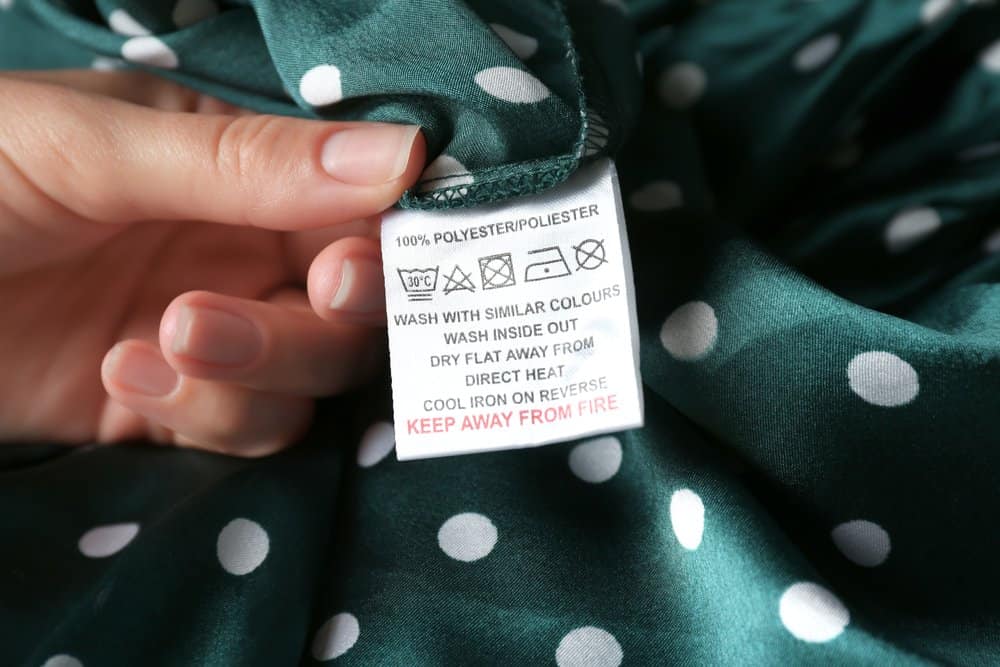Cotton Vs Polyester: Which Is Best For Hiking?

Apart from looking good on a hike, there are many considerations when choosing the perfect wear for hiking. Hiking gear should be lightweight, quick-drying, and comfortable. Cotton and polyesters are the most widely used fabrics for clothing. So when it comes to cotton vs polyester – which is best for hiking?
Quick Links
Is Cotton or Polyester Better for Hiking?
Let’s just cut to the chase. I’ll take Polyester over cotton ten times out of ten for my hikes. Here’s why: Polyester is lightweight, stronger and more durable than cotton, and excellent at wicking away moisture.
But there are still a few things to consider before you decide. Let’s take an in-depth look at cotton vs polyester, their history, and the advantages and disadvantages when it comes to hiking.
All About Cotton

Cotton is one of the most widely used fabrics due to its comfort and versatility. As a matter of fact, you’re probably wearing cotton right now. It’s often used in everyday clothing such as t-shirts, jeans, and underwear. But is it a good choice for hiking? Let’s take a closer look at the pros and cons of cotton.
Where Does Cotton Come From?
Cotton is a natural fiber that comes from the cotton plant. The cotton plant is native to tropical and subtropical regions worldwide, such as India, Africa, and the Americas. The plant grows best in warm climates with lots of sunlight and rainfall.
The cotton plant has long been cultivated for its fibers, which are used to make a variety of textile products. Cotton is most commonly used for clothing, but it can also be used for towels, sheets, and other household items.
How Is Cotton Made?
Cotton fibers are harvested from the cotton plant using a process called ginning. Ginning is done by machines that strip the seeds and other materials from the plant’s fibers. The resulting product is a soft, fluffy material called “cotton lint.”
Cotton lint is then spun into yarn or thread, which can be used to make a variety of textile products.
What Are the Benefits of Cotton?
Cotton is a very popular fabric due to its many benefits. Cotton is:
- Soft and comfortable: Cotton fibers are soft and gentle on the skin, making them a comfortable choice for clothing.
- Breathable: Cotton is a natural fiber that allows your skin to breathe. This makes it an ideal choice for warm-weather clothing.
- Absorbent: Cotton fibers are absorbent, making them ideal for towels and other household items.
- Hypoallergenic: Cotton is a hypoallergenic material, making it less likely to cause an allergic reaction.
- Affordable: Cotton is one of the most affordable natural fibers. It is widely available and used in a variety of products.
What Are the Disadvantages of Cotton?
Cotton does have a few drawbacks that you should be aware of. Cotton is:
- Heavy and bulky: Cotton fibers are heavier and bulkier than synthetic fibers such as polyester. This makes cotton clothing less ideal for hiking, as it can add extra weight to your backpack.
- Slow to dry: Cotton absorbs moisture from the skin, making it slow to dry. This can be a problem if you’re sweating on a hike or if you get caught in the rain.
- Prone to wrinkles: Cotton clothing is prone to wrinkles. If you’re trying to pack light for a hike, this can be a problem.
- Not ideal in cold weather: Cotton does not insulate well, making it less suitable for cold-weather hikes.
All About Polyester

Polyester is a synthetic fabric that was first developed in the 1940s. It’s made from petroleum-based products, such as coal and petroleum. Polyester is most commonly used in clothing, but it can also be used for other textile products such as carpets and upholstery.
How Is Polyester Made?
Polyester is made by combining two types of materials: alcohol and acid. The resulting product is a long chain of molecules called “polyester.” Polyester can be made into various textile products, such as fabric and thread.
What Are the Benefits of Polyester?
Most activewear today is made with polyester. It is synthetic, but it has many properties that make it superior to cotton for outdoor activities. Here are some of the benefits:
- Lightweight: Polyester is much lighter than cotton, ideal for hiking and other outdoor activities.
- Quick-drying: Polyester absorbs less moisture than cotton, making it quicker to dry. This is a significant advantage if you’re sweating on a hike or if you get caught in the rain.
- Wrinkle-resistant: Polyester clothing is less likely to wrinkle than cotton clothing. This is convenient if you’re trying to pack light for a hike.
- Affordable: Polyester is one of the most affordable synthetic fabrics. It is widely available and used in a variety of products.
What Are the Disadvantages of Polyester?
Polyester does have a few drawbacks that you should be aware of. Polyester is:
- Not as breathable as cotton: Polyester is made from petroleum-based products, which makes it less breathable than cotton. This can be a problem if you’re hiking in warm weather.
- Non-biodegradable: Polyester is a synthetic fabric, which means it’s not biodegradable. This can be a problem if you’re trying to reduce your environmental impact.
- Non-hypoallergenic: Polyester is not hypoallergenic, meaning it can cause an allergic reaction in some people.
Cotton vs Polyester: How To Choose the Right Fabric for Hiking
Choosing the right fabric for hiking can be daunting, especially for beginners. It is essential to wear clothing that will keep you safe and comfortable. And sometimes, you just want to look good and wear your favorite pair of jeans. However, before choosing a fabric, there are clearly specific characteristics you should look out for in selecting the best material and clothing for hiking.
In my opinion, there are three essential questions you need to ask when it comes to cotton vs polyester for the best hiking clothes:
- Is it durable?
- Is it lightweight?
- Is it quick-drying?
Why Is Durability Important?
Your hiking gear needs to be durable enough to withstand the elements and rugged terrain. The last thing you want is for your clothes to tear or break while you’re out on the trail.
What Is Lightweight Clothing?
So what do I mean by lightweight? You need to be able to move freely while hiking, so it’s essential that your clothing is lightweight. Heavy clothing can slow you down and tire you out on the trails.
Is It Moisture-Wicking?
When you’re hiking, you will sweat. It’s essential that your clothing is quick-drying to stay comfortable and dry.
Now that that’s out of the way, there are a few more factors to consider next:
The climate: If you’re hiking in warm weather, you’ll want a light and breathable fabric. Cotton or linen would be a good choice. If you’re hiking in cold weather, you’ll want a fabric that’s insulating. Wool, such as Merino Wool or synthetic fabrics would be a good choice.
The activity: If you’re doing a strenuous hike, you’ll want a quick-drying fabric. Polyester or nylon would be a good choice. If you’re doing a leisurely hike, cotton or linen would be a good choice.
Your personal preference: Ultimately, the best fabric for hiking is the one that you’re comfortable with. If you don’t like the feel of synthetic fabrics, then cotton or linen would be a better choice. If you don’t like the feel of natural fibers, then polyester or nylon would be a better choice.
Is a Poly-Cotton Blend Good for Hiking?
Now that we’ve gone over the different fabrics and put cotton vs polyester side-by-side, let’s talk about poly-cotton blends. Poly-cotton blends are a mix of synthetic and natural fibers. The most common ratio is 65% cotton and 35% polyester fibers. This blend is versatile can be used to make various types of clothing.
Poly-cotton blends have the benefits of both fabrics – but also some of the drawbacks. They are lightweight, quick-drying, and durable. However, they can also be less breathable and more expensive than 100% cotton or polyester fabrics.
So, is a poly-cotton blend good for hiking? I would say yes, but it depends on your personal preference. If you’re looking for a lightweight and quick-drying fabric, then a poly-cotton blend would be a good choice. If you’re looking for more breathable and natural fabric, then 100% cotton or linen would be a better choice.
Again, the main advantage of a poly-cotton blend is that it combines the best properties of both fabrics. It is lightweight and breathable like cotton but also wrinkle-resistant and quick-drying like polyester.
What Are the Disadvantages of A Poly-Cotton Blend?
There are a few drawbacks to consider when choosing a poly-cotton blend:
- Shrinking: Poly-cotton blends can shrink more than 100% cotton fabrics. This is because the polyester fibers are less elastic than the cotton fibers.
- Pilling: Poly-cotton blends can pill more than 100% cotton fabrics. Pilling is when small balls of fabric form on the surface of the fabric.
If you cannot choose between cotton and polyester, think about going for a poly-cotton blend.
Why Is Cotton Not Good for Hiking?

Cotton is an obviously popular choice for everyday clothing because it’s soft, absorbent, and comfortable. However, there are some major drawbacks to consider when choosing cotton vs a polyester fabric for hiking.
There’s a saying in hiking that “cotton kills.” There are two main reasons for this: Insulation and lack of moisture-wicking properties.
Cotton does not insulate when wet. When cotton gets wet, it actually conducts heat away from your body 20 times faster than when it’s dry. This means that if you’re hiking in the rain, your cotton clothing will actually make you colder.
Have you ever been caught in the rain with your favorite pair of jeans? You probably came back home with the shivers, even if it was a warm day. In severe cases – this can actually lead to hypothermia.
Cotton also doesn’t have moisture-wicking properties. This means that it won’t pull sweat away from your skin like synthetic fabrics will.
If you’re hiking in warm weather, this isn’t a big deal – you’ll probably just end up with a sweaty shirt, maybe some chafing, rashes, and even blisters. And of course, you always need to be careful of heat stroke. However, if you’re hiking in cold weather, this can be a major problem. When your sweat gets trapped next to your skin, it lowers your body temperature because the sweat was being absorbed by the fabric and not evaporating.
So, why is cotton not good for hiking? Because it doesn’t insulate when wet and it doesn’t have moisture-wicking properties – two things that are essential for hikers.
Which Is Warmer, Polyester or Cotton?
Polyester is considered to be a much warmer material than cotton. Polyester is a synthetic material, which means that it does not allow your body to breathe as easily as cotton. As a result, polyester is often considered to be the better choice for winter clothing. If you’re planning a hike in the wintertime, you’ll want to make sure you’re dressed in polyester rather than cotton.
Is Cotton or Polyester Cooler in Summer?
Cotton is often thought of as a summer fabric because it is so light and airy. It’s the perfect choice for hot days when you want to stay cool and comfortable. However, cotton can also be a good choice for winter clothing if you choose the right type.
Heavyweight cotton fabrics are available that can provide a good deal of warmth. So if you’re looking for a material that can be used for both warm and cold weather, cotton is a good option to consider – just not for heavy-duty hiking.
Conclusion
So, which should you choose for your next hike? Cotton or polyester? Ultimately, it depends on the conditions and your personal preferences. Polyester is a good choice if you’re looking for something that will keep you warm when it’s cold and dry when it’s wet. However, cotton can be more comfortable in hot weather and may be better suited to people prone to sweating. Experiment with different materials and see what works best for you – just make sure to stay safe while hiking!






